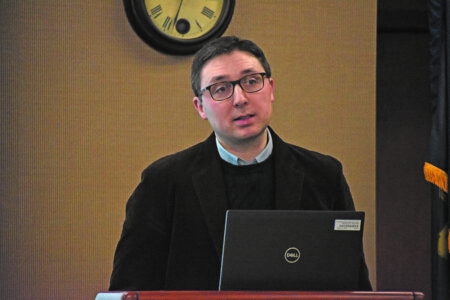Hunters share concern with testing for Chronic Wasting Disease

Michigan Department of Natural Resources White-tailed deer in Michigan.
Editor’s note: This story is a continuation of our Chronic Wasting Discase coverage from Thursday’s edition.
ALTERNATIVE METHODS
If Copper Country hunters are forced to give up baiting, hunter’s safety instructor Dave Caspary thinks more devoted hunters will return to hunting like Keith Machiela does.
“I don’t use bait, but I’m a minority there,” Machiela said.
Machiela is another hunter safety instructor. He and Caspary are leaders in separate local sportsmen’s groups.
Machiela hunts on commercial forest and federal land, searching for signs of deer before settling down to wait, possibly for hours, without an established blind. Caspary used to hunt this way, too. Both hunters worry that more hunters spending time walking the forests could mean more accidental shootings as hunters cross paths. Baiting, on the other hand, keeps hunters in place, often in established blinds and more frequently on private land.
“You can hunt a 5-acre parcel if you’ve got something to draw them in,” he said.
The sportsmen also worry that hunting will become far more difficult as deer become more scarce, either from lack of feeding or the impact of Chronic Wasting Disease (CWD).
Caspary recalled hunting the Keweenaw Peninsula in the 1980s before feeding areas built up the deer herd.
“If we saw a deer track, it was a good season,” he said.
Machiela thinks fewer people, particularly youth, will spend time hunting if the hope of getting a deer grows smaller– either because of the lack of baiting, or because the deer herd shrinks from lack of feeding or directly from CWD’s effects. He fears some hunters might quit because they’re either physically unable to hunt without bait, or never learned how to.
THE TROUBLE WITH TESTING
Machiela, and many other hunters, have questioned how the MDNR knows CWD is always fatal if testing can only be done on dead animals.
“That’s actually a really good question,” Chad Stewart, DNR deer and elk biologist, said when asked by the Gazette.
Testing is actually possible on live specimens, he explained.
“They’ve done tonsil biopsies,” Stewart said.
Stewart said no living deer that has tested positive for CWD has ever recovered.
The problem with the live testing is that CWD is a slow, progressive disease, and does not typically show up in tonsils and other more accessible glands until it is advanced. Relatively healthy deer, like Caspary’s from Wyoming, only show presence of the disease in deeper, less accessible tissue. A tonsil test likely would have returned a negative result.
While this isn’t likely much of an issue for a hunter, using faulty tests that return false negatives to track and attempt to contain the spread of CWD would create fatal inaccuracies in the MDNR’s data. Capturing live, wild deer for testing is also difficult and expensive, especially at the scale needed for CWD monitoring.
Between the less accurate results and the high cost of capturing and testing live deer, Stewart said the MDNR has opted to focus on post-mortem testing.
This season, as of Jan. 10, the MDNR has tested a total of 19,635 deer carcasses for CWD, 1,499 of them in the Upper Peninsula’s surveillance areas. However, the MDNR goal for the core area of surveillance in the UP was 2,654 tests and they only reached 727. While the results are still useful, it doesn’t give the MDNR the 95% statistical confidence they want in their estimates of CWD’s prevalence.
Stewart said they will probably keep looking for ways to acquire more test results the core areas that fell short of their goal.
A LOOK TO THE FUTURE
Stewart sees a broad range of possible futures for Michigan’s deer herd.
Optimistically, if containment and management is well-supported by hunters and the public, negative impacts could be delayed and a reasonable deer population maintained.
“Maybe we can live with the disease,” he said.
CWD does not progress quickly, so Stewart has hope that a healthy deer herd could persist as long as the concentration of infected deer and environments is kept low and the disease’s spread controlled.
Alternatively, if the disease is allowed to spread quickly and build concentrations of infected environments and deer, the herd could shrink significantly.
“People will start to see visibly ill deer on the landscape,” Stewart said.




